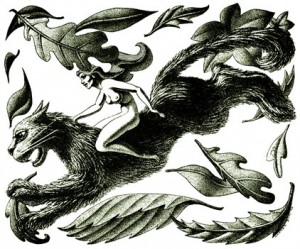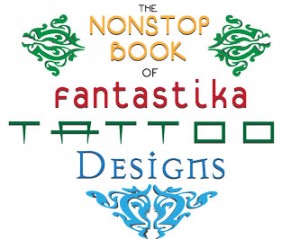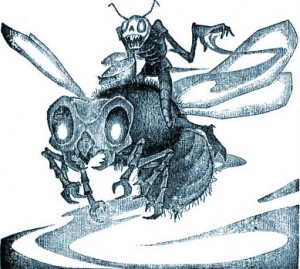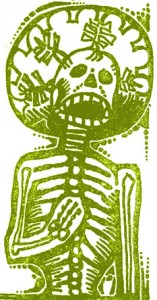Excerpt from THE NONSTOP BOOK OF FANTASTIKA TATTOO DESIGNS by K.J. Cypret.
He had seen her painted sign by the road: SKIN ILLUSTRATIONS! Illustrations instead of tattoo! Artistic! So he had sat all night while her magic needles stung him wasp stings and delicate bee strings. By morning he looked like a man who had fallen into a twenty-color print press and been squeezed out, all bright and picturesque.”
– Ray Bradbury, The Illustrated Man
THE IDEA of doing a book on fantastic tattoo designs first entered my head around 2004, when I began seeing people riding the subways in New York City that reminded me of Ray Bradbury’s Illustrated Man. Skin ink had been accepted into the vernacular of the country and it was certainly easy to find people with all sorts of skin illustrations walking about the city. I especially noted that the open by-ways of New York had become a gallery of the fever dreams and fantasies. A lot of the tattoos I saw also seemed somewhat familiar to me, and one day it came to me: the malformed monsters, screaming demons, and winged, nude nymphs navigating the expanse of flesh— much of it was just weird pulp art transformed, an exhibition of fantastika (horror, fantasy and science fiction) art on permanent display, at least during the span of the exhibiting person’s lifetime.
In the city in which I traveled resided, a cool tribe of post 9/11 hustlers, slouchers and even businessmen allow themselves to be branded by even cooler artists and both artist and patron were indirectly channeling long dead pulp artists from the mid-20th century – drawing inspiration from art that had been originally done for cheap pulp paper instead of skin. If you navigate the streets of NYC and check out all the illustrated people you will sooner or later come upon remnants of weird pulp art.
It seems that a small group of artists had pulp ink in their tattoo machine reservoirs. One of the more colorful tattoos I saw at the time appeared familiar and I wished I had my Olympus with me so I could get a picture of it. Some days afterwards I realized it was a Hannes Bok-inspired nymph riding a gigantic cat.

Bok was a self-trained artist from Kansas City. He came to New York City, by way of California, at some point around World War II. Bok was serious about art, even if the bulk of his artwork appeared in 25-cent magazines located in the back section of newsstands. His thing was Maxfield Parrish art and the writings of fantasist Abe Merritt. At first he mixed pulp art motifs with a Parrish influenced drawing style but soon developed his own art manner. Bok tried to follow in Parish’s footsteps by using a muted color palette in his paintings done for pulp magazine covers. This style only really worked in places like Weird Tales and appears to have limited Bok’s illustration market. But Bok’s real talent lay in black and white interior illustrations. The inside story on the man was that he was gay. Very few people realized this at the time—even some of his closest artist friends. It was a different time then.
Bok was an eccentric unwilling or unable to make conformist adjustments when it came to art and as a result lived an impoverished and shortened life. He once stood outside of Edgar Allan Poe’s house on West 3rd Street, staring jovially up at the windows. He had hiked all the way downtown from his top-floor walk-up apartment on West 144th Street and felt some kind of kinship with the downtrodden writer. Just like Poe, clients always exploited and underpaid Bok during his lifetime, and just like with Poe, the city showed no favoritism to Bok. Yet, unlike Poe, for the most part Bok remained a happy creator with supreme imagination until one day in 1964 he rested his head on a thin pillow and never woke up. He was 49 years old.
Bok, Dolgov and Gaughan are just a few of the fantastic artists represented in THE NONSTOP BOOK OF FANTASTIKA TATTOO DESIGNS.
(TOP: Art by Hannes Bok; MIDDLE: Art by Boris Dolgov; BELOW: Art by Jack Gaughan)



Write a Comment